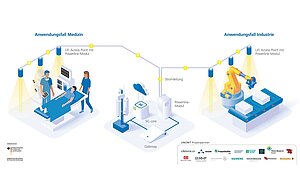March 15, 2022
At the beginning of 2022, LINCNET, a strategic project funded by the German Federal Ministry for Economic Affairs and Climate Action (BMWK), was launched. LINCNET, which receives 3.3 million euros in funding, stands for "LiFi-assisted 5G for industrial and healthcare networks." The project will run for three years. Fraunhofer Heinrich Hertz Institute’s (HHI) scope is to work with 14 partners researching networking solutions to combine the transmission technologies Light Fidelity (LiFi), Powerline Communication (PLC) and 5G in an intelligent way. The project aims to advance digitization in the healthcare sector as well as in industrial environments. The objective is to strengthen Germany's economic edge and to achieve technological sovereignty. In the project, Fraunhofer HHI is responsible for research and development in the field of optical wireless communication.
The focus of the project and one of the goals is to enable the use of optical wireless communication with light, called LiFi, in professional environments. The LINCET team aims to adjust the technology so that it can be used in various applications as a complement to 5G radio communications. To accomplish this, the researchers will work with PLC, a technology that uses existing cabling for data transmission to create a link between LiFi and 5G.
Application in sensitive environments
Using 5G and WiFi in medical or industrial settings brings some challenges such as potential interferences, bandwidth conflicts, or eavesdropping. Therefore, the LINCNET team will develop solutions for sensitive environments with highest requirements for transmission rates, security, flexibility and electromagnetic compatibility. LINCNET will extend 5G networks for specific applications. This opens up promising opportunities for the use of 5G in medical and industrial environments.
In the medical field, for example, this can improve the connection and operation of imaging sensors such as endoscopes, X-ray or ultrasound equipment. Digital patient records will thus become easier to use. In the industrial environment, LINCET technology will simplify the conversion of production lines and production environments. “To enable greater product diversity, production lines need to become increasingly flexible. Regular rewiring would be far too expensive”, comments Dr. Anil Mengi, LINCNET coordinator at the project partner devolo. “Intelligently connecting different communication technologies will create significant benefits for productivity and efficiency.”
LiFi uses natural properties of light
To realize the mentioned improvements, LINCNET combines the advantages of different technologies. "LiFi uses the unlicensed optical spectrum and complements radio technologies in terms of higher data rates in small areas, especially in buildings. Light waves are not susceptible to electromagnetic influences and propagate only in a limited area," says Dr. Dominic Schulz, LINCNET project manager at Fraunhofer HHI. "The natural properties of light make LiFi communications particularly robust, stable and secure."
LiFi products are already available. Until now, however, their network connection has been complicated. LINCNET aims to considerably simplify the connection. To achieve this, the project relies on PLC as the backbone technology. PLC uses existing power lines for data transmission, thus upgrading them to data cables. This eliminates the need for expensive additional cabling. With this approach, the project team will reduce cost and improve hygiene in the medical sector. 5G technology completes this solution and, with its high transmission rates and low latency, guarantees the performance needed for real-time applications.
Project goals cover theory and practice
The LINCNET partners strive to achieve various goals together. For example, in addition to integrating LiFi and PLC into practical, cost-effective solutions, they want to create a uniform network management system. Furthermore, the partners will work on developing LINCET applications for the home network sector. Lastly, the project results will be incorporated into the work of international committees, thus contributing to the development and improvement of standards for wireless and wired communication.
The project partners include large companies as well as small and medium-sized enterprises and research institutions. In addition to Fraunhofer HHI, the following partners are involved in the project: BISDN GmbH, devolo, IAF GmbH, Indu-Sol GmbH, Technische Universität Berlin, Thiem-Research GmbH/Carl-Thiem-Klinikum Cottbus and Smart Mobile Labs AG. Associated partners are Deutsche Bahn, MHP Management- und IT Beratung, Rohde und Schwarz, Siemens AG, Volkswagen AG, VPIphotonics and Weidmüller Interface.
